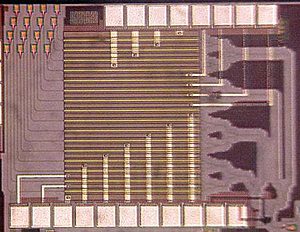Imagine going to a meeting, flipping your phone on the table and then instantly project your slide presentation or traveling to a remote location, where there aren’t any displays or projectors, and use nothing but your phone to project a multimedia application [a movie, a video game, etc.]. Such ideas are being currently manipulated by scientists into working applications. First steps into directions are already crossing reality as Caltech engineers report they used a light-bending silicon chip to project simple images like triangles and smile faces in infrared red.

The resulting technology only covers a few square millimeters, opposed to the bulky projectors that use large and expensive lenses, along with moving parts. Traditional projectors, like the LCD projector, use a beam of high-intensity light which travels through thousands of shifting pixels in an LCD display. Before your image is actually projected, the beam of lights travels through multiple mirrors that act like a prism, decomposing light into three constituent primary colours. Lenses map each point of the small picture to corresponding, yet expanded, points on a large screen.
Ali Hajimiri, Thomas G. Myers Professor of Electrical Engineering, and researchers in his laboratory chose to bypass traditional optics and go on an alternate route. Instead of having hardware that manipulates light in multi-stage steps, the researchers exploited light coherence – a property that allows the researchers to “bend” the light waves on the surface of the chip without lenses or the use of any mechanical movement.
Two waves are coherent (light is both wave and particle) if their peaks and troughs of are exactly aligned with one another. Any coherent waves also combine, so instead of two separate waves, if these waves are coherent you’ll get one beam with twice the amplitude and four times the energy as the initial wave, moving in the direction of the coherent waves.
“By changing the relative timing of the waves, you can change the direction of the light beam,” says Hajimiri. For example, if 10 people kneeling in line by a swimming pool slap the water at the exact same instant, they will make one big wave that travels directly away from them. But if the 10 separate slaps are staggered—each person hitting the water a half a second after the last—there will still be one big, combined wave, but with the wave bending to travel at an angle, he says.
The Caltech researchers devised what’s called an integrated optical phased array (OPA) to project images electronically with only a single laser diode as light source and no mechanically moving parts. The team used a series of pipes for the light in the OPA to slow down or speed up the timing of the waves, just like in the separate slaps beating in the water example.
A single beam projector in your pocket
The image to be projected is sent to a computer which converts it into multiple electrical currents of varying currents. These stronger or weaker currents are applied to the light within the pipes, varying the number of electrons within each light path, in turn changing the timing of the light wave. Timed light is delivered through tiny array elements within a grid on the chip, with each array projecting light. The grid combines coherently each individual array in the air to form a single beam and a spot on the screen.
The interesting part is that, unlike a traditional projector that projects a whole image than swaps it really fast frame by frame, the OPA tiny light-bending projector works by rapidly swinging the beam left, right, up or down. This beam is electronically controlled, not through moving parts like a motor, so the beam move extremely fast on a projected surface thus giving the impression that a geometrical pattern like a triangle or circle is projected as a whole, when in reality an individual point of light is moving so fast your eyes can’t tell the difference.
“The new thing about our work is really that we can do this on a tiny, one-millimeter-square silicon chip, and the fact that we can do it very rapidly—rapidly enough to form images, since we phase-shift electronically in two dimensions,” says Behrooz Abiri, a graduate student in Hajimiri’s group and a coauthor on the paper.
The demonstrations made so far were made using infrared light because they used a silicon chip – a material that is widely available. Using different semiconductors or semiconductor joints, the researchers can expand their demos to visible light as well.
“Right now we are using silicon technology, which works better with infrared light. If you want to project visible light, you can take the exact same architecture and do it in what’s called compound semiconductor III-V technology,” says Firooz Aflatouni, another coauthor on the paper, who in January finished his two-year postdoctoral appointment at Caltech and joined the University of Pennsylvania as an assistant professor. “Silicon is good because it can be easily integrated into electronics, but these other compound semiconductors could be used to do the same thing.”

Credit: Ali Hajimiri/Caltech
“In the future, this can be incorporated into a phone, and since there is no need for a lens, you can have a phone that acts as a projector all by itself,” Hajimiri says. However, although the chip could easily be incorporated into a cell phone, he points out that a tiny projection device can have many applications—including light-based radar systems (called “LIDAR”), which are used in positioning, robotics, geographical measurements, and mapmaking. Such equipment already exists, but current LIDAR technology requires complex, bulky, and expensive equipment—equipment that could be streamlined and simplified to a single chip at a much lower cost.
“But I don’t want to limit the device to just a few purposes. The beauty of this thing is that these chips are small and can be made at a very low cost—and this opens up lots of interesting possibilities,” he says.






